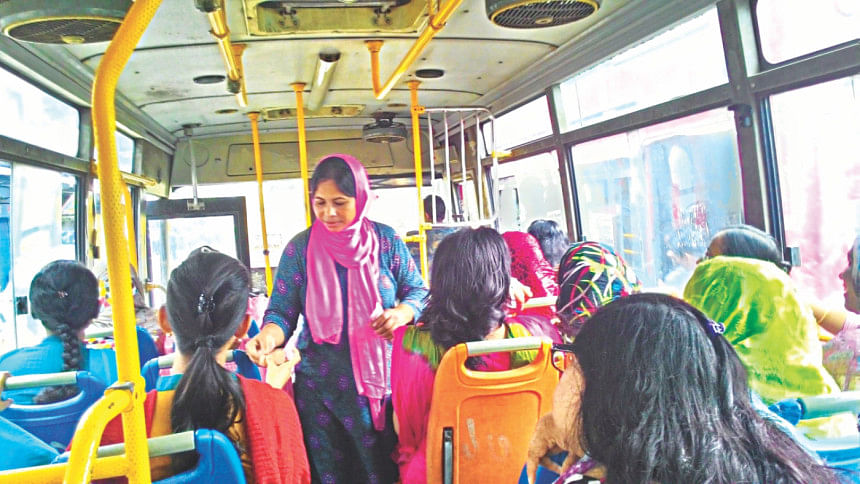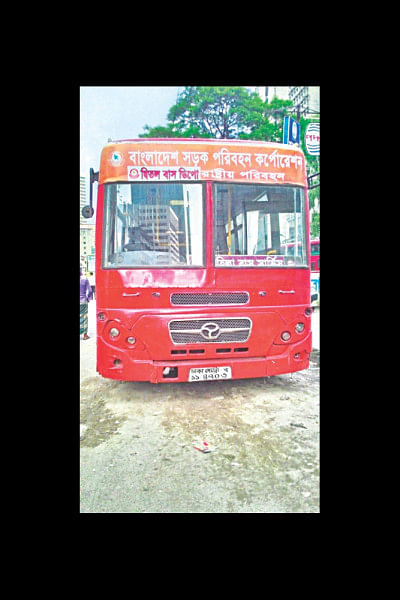Woes of women commuters

For Aliza Shikder, commuting between home and office is an everyday battle.
To fight her way through the city, the 25-year-old must wear a stern look and maintain a sharp tongue -- from finding a bus to getting a comfortable seat free from unwanted touch by male passengers to paying her fare.
"Often, I have to almost beg bus conductors to let me board when I come home after office hours," she told The Daily Star.
"Even if they allow us [female passengers] in, they charge us more than the stated fare," she alleged.
Aliza, who travels six days a week between Mirpur-12 and Purana Paltan around 7:00am and 6:00pm, takes private buses although a government-run women-only bus plies that route during the time.
These female-only buses, run by Bangladesh Road Transport Corporation (BRTC), are safer for women in many ways than those run by private operators. But there are only a handful of them, making their service limited and slow.
"It stops frequently to pick up women and so I cannot reach my workplace before 9:00am," said Aliza, a private firm employee.

She stopped using the service after she had to get down from the BRTC women-only bus twice and use other vehicles to reach her office on time.
In Dhaka, there are some 41 lakh economically active population aged 15 years and above. Of them, about 12 lakh are women, according to the Bangladesh Bureau of Statistics Labour Force Survey 2010.
A baseline study on 800 women and girls and 400 men and boys shows 86 percent women face derogatory comments from bus drivers and conductors. In the 2014 survey done by ActionAid Bangladesh, 37 percent respondents said the number of women-only buses in the city was inadequate.
The study found that about 13 percent women keep from public transports to avoid sexual harassment.
The government introduced the women-only bus service in 1997 in the capital. Initially, only two buses plied Mohakhali-Tongi route for working women, BRTC sources said.
As of October 2015, there were 16 such single- and double-decker buses. They ply just 12 of the capital's 88 routes, and have a little over 2,000 seats in total. Their service is limited as well. They run twice a day -- between 6:30 and 8:30 in the morning and 5:00 and 6:30 in the evening.
So, the service is of no use to Nusrat Impa. A journalist, she does not have a fixed office timing. As a result, she cannot take these buses although she would prefer it.
Supreme Court lawyer Shamsun Nahar Lovely also cannot enjoy this service when she returns home around 2:00pm.
The single-decker BRTC bus she takes in the morning from Mirpur-14 picks up working women along Mirpur-10, Farmgate, Press Club, Gulistan and Motijheel route. The bus is then parked near Notre Dame College and remains inoperative till evening, when it returns to Mirpur, picking up women along the way.
Throughout the day, the drivers and helpers (who are women) sit idle.
Despite the seemingly high demand for the service, BRTC Chairman Mizanur Rahman said the female-only buses don't even get filled and are therefore not profitable.
He said they got two to three female passengers at best at every stop. "Most women travel with their male friends, husbands or sons."
The BRTC boss cited the example of the female-only bus service from Ikuria to Abdullahpur. The service on the 7km road on Mawa route opened after the government banned auto-rickshaws on the highway earlier this year.
"Sometimes, it runs with a single female passenger. On the down trip, we get five to ten female passengers. But still we are running the service," Mizanur said.
Khandaker Enayetullah, secretary general of Bangladesh Sarak Paribahan Samity, supported Mizanur.
Transport expert Prof Shamsul Hoque said the solution lay in an "organised mass transport system," not in introducing more women-only buses or in reserving more seats for women.
"At present, small companies operate their buses in the city, and the drivers and conductors are not salaried employees. Their earnings depend on the number of passengers they take.
"To drivers and conductors, female passengers are slow to get on the bus and require more room. So, they have negative attitudes towards female passengers," said Prof Shamsul, who teaches civil engineering at Buet.
In developed countries with organised public transport system, governments hire big companies who run wide and multi-door buses on designated routes.
"This way, women do not have to face harassment while boarding and disembarking the vehicle. Also, there is no crowd inside the bus because drivers there are salaried employees and do not have any incentive for carrying extra passengers," he said.
The government needs to take a long-term initiative to introduce this system and encourage large corporate houses to invest in the sector. This will not only solve the problems faced by female commuters but also ease traffic jam.

 For all latest news, follow The Daily Star's Google News channel.
For all latest news, follow The Daily Star's Google News channel. 



Comments